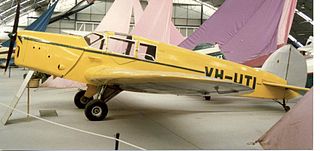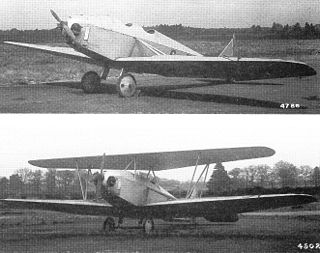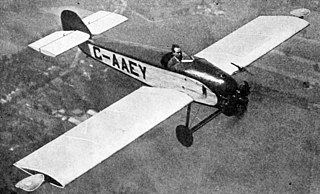 | |
| Industry | Aircraft design |
|---|---|
| Founded | 1928 in Brighton, East Sussex, England |
| Founders |
|
| Defunct | 1935 |
| Fate | Merger |
| Successor | Parnall Aircraft Ltd. |
Number of employees | 2 |
The Hendy Aircraft Company was an early 1930s British light aircraft design company.
 | |
| Industry | Aircraft design |
|---|---|
| Founded | 1928 in Brighton, East Sussex, England |
| Founders |
|
| Defunct | 1935 |
| Fate | Merger |
| Successor | Parnall Aircraft Ltd. |
Number of employees | 2 |
The Hendy Aircraft Company was an early 1930s British light aircraft design company.
The company was formed as a partnership between Basil B. Henderson and H.A. Miles at 7 Park Lane, London, with Henderson being the chief designer. [1] Most of the aircraft were built by Parnall & Sons and in 1935 Parnall Aircraft Limited was formed when the two companies were merged along with Nash and Thompson Limited. [2]
Parnall was a British aircraft manufacturer that evolved from a wood-working company before the First World War to a significant designer of military and civil aircraft into the 1940s. It was based in the west of England and was originally known as George Parnall & Co. Ltd.
The Cirrus and Hermes or Cirrus-Hermes are a series of British aero engines manufactured, under various changes of ownership, from the 1920s until the 1950s. The engines were all air-cooled, four-cylinder inline types, with earlier ones upright and later designs inverted.

The Percival Gull was a British single-engined monoplane, first flown in 1932. It was successful as a fast company transport, racing aircraft and long-range record breaker. It was developed into the Vega Gull and the Proctor.

Nash & Thompson was a British engineering firm that developed and produced hydraulically operated gun turrets for aircraft. As part of Parnall Aircraft it was also an important manufacturer of hydraulic-powered radar scanners used on radar systems such as H2S and AI Mark VIII.

The Parnall Heck was a 1930s British four-seat cabin monoplane built by Parnall Aircraft Limited at Yate, Gloucestershire. Originally a Hendy design, few were built. It combined the strength and comfort of a cabin aircraft with the speed of a racer.

Dart Aircraft Limited was a British aircraft manufacturer during the 1930s. Its facilities were located at 29 High Street North, Dunstable, Bedfordshire.
Air Navigation and Engineering Company Limited was a British aircraft manufacturer from its formation in 1919 to 1927.

The Luton L.A.5 Major was a 1930s British two-seat high-wing cabin monoplane. Following World War II, plans were made available to suit construction as a homebuilt aircraft.

The Miles M.2 Hawk was a twin-seat light monoplane designed and produced by the British aircraft manufacturer Miles Aircraft Limited during the 1930s. It is the first of the company's aircraft to attain quantity production.

The Miles M.7 Nighthawk was a 1930s British training and communications monoplane designed by Miles Aircraft Limited.
The Hendy 281 Hobo was a British single-seat light monoplane designed by Basil B. Henderson and built by the Hendy Aircraft Company at Shoreham Airport in 1929. Only one aircraft was built, registered G-AAIG, and first flown in October 1929 by Edgar Percival.

The Hendy 302 was a British two-seat cabin monoplane designed by Basil B. Henderson and built by George Parnall & Company Limited at Yate in 1929. Only one aircraft was built registered G-AAVT.

The General Aircraft ST-18 Croydon was a 1930s British cabin monoplane built by General Aircraft Limited.

The British Aircraft Manufacturing Company Limited was a 1930s British aircraft manufacturer based at London Air Park, Hanworth, Middlesex, England.
Nicholas Comper was an English aviator and aircraft designer, whose most notable success was the 1930s Comper Swift monoplane racer.

The Parnall 382 was a 1930s British single-engined monoplane trainer aircraft with two open cockpits, designed and developed by Parnall Aircraft Ltd.

The Parnall Pixie was a low powered British single-seat monoplane light aircraft originally designed to compete in the Lympne, UK trials for motor-gliders in 1923, where it was flown successfully by Norman Macmillan. It had two sets of wings, one for cross-country flights and the other for speed; it later appeared as a biplane which could be converted into a monoplane.

The Henderson-Glenny H.S.F.II Gadfly was a British single-seat low-wing monoplane designed by K.N. Pearson and built by Glenny and Henderson Limited at Byfleet, Surrey, England in 1929.
The Hinkler Ibis was a British two-seat wooden amphibian monoplane designed and built by the Australian aviator Bert Hinkler while working in the United Kingdom.
The Simplex Red Arrow was a US single-engined monoplane produced in the late 1920s and early 1930s and intended as club machine or mail transport. Most used radial engines in the 90–110 hp (67–82 kW) range. They carried one or two passengers whose seats could be open or enclosed. One variant, the Red Arrow Dual Plane, was easily converted from monoplane to biplane and was available with two versions of the much more powerful Wright Whirlwind engines. In all about 20 were built.